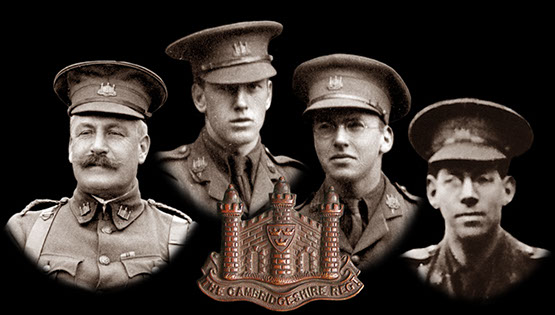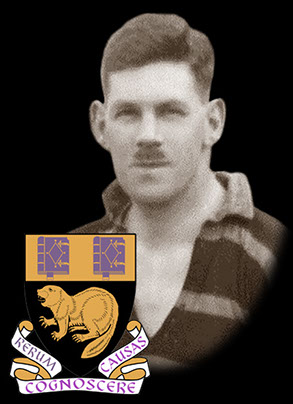
The Tebbutt Family at War: Louis and his three sons, Oswold, Roger and Charles.
Captain Charles Louis Tebbutt MC
The youngest of the three Tebbutt brothers, Charles was born in Cambridge in 1897. After attending St Faith’s Cambridge he went to Bootham School, York and during his time at school developed a love of rugby. On finishing his education at Bootham he returned to Cambridge, however his plans for continuing his studies were interrupted by the outbreak of war in Europe.
In the weeks following the outbreak of war in August 1914, at the age of 17, Charles, desperate to join his father and two older brothers, applied for a commission with the Cambridgeshire Regiment. He was commissioned as a 2nd Lt in November 1914, however his poor eyesight and young age led to him being rejected for active service and he was posted to the 1st Reserve Battalion (later called the 2/1st Battalion). His frustration at being prevented from overseas service was shared by his father, Lt Col Louis Tebbutt, who was also being prevented from overseas service on medical grounds. Charles’ unrelenting determination to overcome this obstacle was further fuelled after the sad news that Oswold, this oldest brother, had been killed at St Eloi in March 1915.
In the summer of 1915 men who were unable to serve overseas such as Charles were moved from the 2/1st Battalion to the newly formed 62nd Provisional Battalion. For Charles this posting seems to have been only been an administrative transfer as he remained attached to the 2/1st Battalion, spending time as the Battalion’s bombing instructor. Two years after his commission and after repeated attempts to be posted to the front, Charles finally got his wish and in late November he sailed for France. On arrival at the 39th Division he spent two weeks with the 1/1st Cambs before, due to his fluent German, he was attached to the 116th Brigade as Intelligence Officer for two months.
By late February 1917 Charles returned to the 1/1st Cambs and was posted to B Coy as a platoon commander. During the cold winter months around the Ypres Canal dugouts Charles managed to find a pair of old ice skates in the ruins of Ypres and he put them to good use. The rather surreal sight of Charles skating on the frozen canal soon became a common one whenever the Cambs were back from the frontline. Before long he had proved that he was a quick thinking and reliable officer and was made Battalion Intelligence Officer, which included command of the scout section. With the summer fast approaching and the massive build up of men and supplies in the Salient, Charles was soon to find himself in the thick of the fighting on what was to prove to be the Battalion’s most costly day of the War.
On the morning of 31st July 1917 the Cambridgeshires started their long advance to their start objective, crossing over the old British trenches, following behind the assaulting formations. Despite thick fog Charles’ scouts did good work making sure the Cambs kept on track and arrived at their first objective on time. Further details about the Cambridgeshires on this day can be found on the following page of this site. As the attack in front of the Cambs failed and the intense German counter-attacks began, Charles and his scouts, including his runner, Sidney Maskell, whose account of the action can be found by clicking here, took up position with the Battalion’s main line of defence.
When Col Clayton and Brig-Gen Riddell were later writing the regimental history, Charles provided them with a detailed written account of his experiences at St Julien. After reaching the positions held by A and D Coys on Hill 19 and having already turned several captured German machine guns on their former owners with devastating effect, he later wrote:
Telling Cpl Tabor I was going back to find the Colonel (Clayton), and telling my servant (Maskell) to go on digging a trench for me (as he had hurt himself going over some barbed wire), I went back over the Hanebeek (east) alone.
He continued: A few minutes later, when walking back, I was aware of a shell bursting close behind me and of a burning sensation in my left hand, and of the fact that I was sitting on the ground. I picked myself up and, on looking at my hand, found that it was mostly gone, and there was a fountain of blood spurting up from the middle of the back of it. Though a bit dazed, I had enough sense to realize that I must stop this, so I grabbed the wrist with my other hand and was relieved to find that the violent spurts stopped.
Charles fortunately stumbled across the Battalion HQ where his wound was bandaged, however it soon became clear the only way back from here was by walking. So setting off once again, aided by a borrowed walking stick and a flask of brandy, Charles slowly made his way back. Despite his shock and blood loss, he eventually reached a First Aid Station near the Canal Bank dugouts.
Charles was quickly evacuated back to England and was rushed to the 1st Eastern General Hospital in Cambridge. The injuries to his left wrist were severe, thankfully his hand was saved apart from his index finger which had been severed. While recovering it was announced that Charles had been awarded the Military Cross for his gallantry at St Julien and the award was officially announced in the London Gazette in late October. The citation for his MC reading:
He behaved with great gallantry throughout the attack, keeping in touch with all the neighbouring units. When the enemy counter attacked he used several captured machine guns with great effect, unitl his hand was nearly shot off. He then returned to battalion headquarters, under intense fire, to report the situation, and gave a clear and valuable report before collapsing from loss of blood. He showed great determination and devotion to duty.
Once fit enough to return to duty Charles spent time with the Cambs and Suffolk Reserve Battalion and at Catterick. Once again the frustration at not being overseas took hold, again amplified after the loss of his second brother, Roger, who was killed in action in August 1918. In September he finally was posted back to the 1/1st Battalion, now with the rank of Captain. He reached the Battalion at a time when experienced junior officers were in short supply and the vicious fighting that had ranged since early August had inflicted heavy losses across all ranks.
Within days of his arrival Charles was in action and commanding A Company as they pushed east. In early October he even commanded the Battalion for a short time after Major Royle was wounded, something that Clayton referred to as: one might say that it was his right both by patrimony and service. Charles gallantly led his company during the attack on Auby, but in the days following the attack received an unwelcome order to return home on compassionate grounds. Apparently a family member had applied to the War Office, stating that as his two brothers had been killed and as his father was serving overseas, Charles should return to England.
Fuming with anger Charles returned to England on 18th October 1918, where he then proceeded to make such a fuss that it was agreed by the War Office that he could return to France. However by the time he returned to the Battalion the Armistice had been signed and Charles had missed out on his last chance for action. He remained with the Battalion during its stay at Somain and was one of the six officers that returned to Cambridge with the final Cadre in May 1919.
On his return to England Charles set about building his life and accepted a place studying commerce at the London School of Economics, although he did most of his studying from the family home in Cambridge. By early 1924 he had found employment with an engineering firm called Henry Smith Ltd, of Manchester and rented a room in Wilmslow. His engagement to Dorothy Awdry Garret, a former VAD nurse from Middlesex, was announced in September. Sadly he was never to marry and, despite all he had already survived, his young life was to be suddenly cut short.
On Saturday, 21st November 1925, annoyed with how busy Lindow Common was with other ice skaters, Charles set off to find a more secluded spot and drove to Lake Redesmere, Cheshire. After skating for a time it is thought that he paused to light his pipe, his now static weight proved too much for the thin ice and he plummeted into the icy water. Unable to extricate himself his repeated shouts for help did alert two boys who were walking nearby. Charles yelled for them to fetch a ladder to place over the ice. The boys found a ladder at a nearby cottage but the elderly occupants were too frail to help with the rescue. On their return with the ladder, not wanting to risk the young boys safety, Charles told them to flag down a passing car. However by the time they returned with additional help Charles had succumbed to the cold deep waters.
Several days later his funeral was held at the St Andrews Street Baptist Church in Cambridge, a mournful event that was attended by many of his former comrades. He is now buried in the Cambridge City Cemetery, the cross above his grave in the form of a stylized Military Cross with the Cambridgeshire Regiment badge in its centre.

Charles Tebbutt, photographed while playing Rugby for LSE after the War (image courtesy of LSE Library).
Links to the other Tebbutt family biographies on this site:

This site went live on the 14th February 2015 to mark 100 years since the 1/1st Cambs went off to war.
WE WILL REMEMBER THEM
Email us: cambsregt@gmail.com
Copyright 2015, 2016, 2017, 2018, 2019 by Felix Jackson. The information and images on this site should not be reproduced without prior permission.